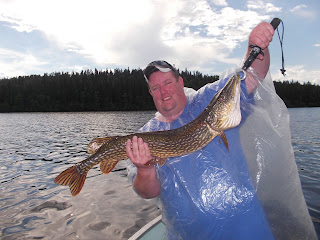Calgary, Alberta is a dream city for any angler. From the city, one can easily access world class trout streams, great ice fishing, stocked trout ponds and numerous lakes and reservoirs with plenty of walleye, pike and perch. Heck, there’s even a Blue-Ribbon trout stream, the Bow River, flowing right through the middle of the city.
The only thing I truly miss while living in Calgary is bass fishing. I love everything about catching smallmouth and largemouth bass, from the way they fight as hard as fish twice their size to how easy it is to lip a hooked bass, pop the hook out and successfully release them alive and well. Unfortunately, there is no bass fishing in Alberta.
That’s why bass fishing is at the top of the list of reasons I get excited for our annual summer trip back to Ontario (just behind seeing family and friends of course). Not only is the bass fishing in Ontario so fun, but I also happen to have access to a family cottage, complete with a 14 foot tin car-topper tied to the dock below our cottage.
 |
| A Fifth Depot Lake sunset |
About 40 minutes north east of Kingston, our cottage is on a little lake with a healthy population of both smallmouth and largemouth bass along with some small pike and a supposed population of walleye. (More about these rumoured walleye to come in a later post).
 |
| A Fifth Depot Lake smallmouth |
This year, we arrived in Ontario in the middle of a heat wave that saw humidex temperatures in the mid 40s. It was brutal. The only thing that got me through this agonizing heat was the thought of drifting over weed beds hunting bass.
The night before we left for the cottage a band of thunderstorms rolled through Southern Ontario and we awoke the next morning to one of those days that you often read about in fishing books and magazines…for all the wrong reasons. The high blue skies and cool breeze that we rose to only meant one thing: I would be spending at least a couple days of my precious bass fishing time in a post cold front nightmare.
Although the conditions were less than ideal, I clearly wasn’t going to spend my days at the cottage sitting on the shore thinking about the weather. So on the day we arrived, I took the boat across the lake to an island point where I’ve had plenty of success in the past. This particular point continues underwater for about 50 feet as a triangle-shaped weed bed before it drops off sharply into about 20 feet of water; a text-book fish-holding spot.
Usually, I kill the motor at the apex of the weed bed and cast crank baits or inline spinners along either side of it. On this particular day, the fish were having nothing to do with these fast presentations so I decided to slow things down by wacky rigging a
Roboworm plastic worm on a #8 octopus hook. The simplest of rigs, a wacky rig is just a softbait with a hook stuck through the middle of it, instead of the end. You don't even use a sinker. I cast the worm out and tried my best to let the worm sink as naturally as possible through the water column. A few seconds later, I was fighting my first largemouth of the trip.
 |
| Fell for the wacky rig |
Despite working immediately, the wacky rigged worm wasn’t without its problems. Because the technique relies on the nearly neutral weight of the worm, hook and line to sink, any slight tension on the line caused by boat drift or choppy water was enough to pull the bait back toward the surface. This technique is also infuriatingly slow.
After struggling to submerge the wacky rigged worms for another half hour, I decided to switch to a drop shot rig. If you’ve read any bass fishing publication over the last couple of years, you’ve read about the drop shot. Basically, a drop shot rig switches the usual positions of the hook and sinker, putting the sinker below the hook. This allows the hook to suspend at fish-mouth level while the sinker maintains contact with the bottom.
 |
| A fat little smallmouth |
I used a 3/8 oz. cylinder drop shot sinker about 12” below a #8 octopus hook on which I stuck a Smoke Purple
X Zone Slammer. Instead of casting the rig, I let the sinker drag along the bottom as the boat drifted along the edge of the weed bed. I also dunked the rig vertically into holes in the weed beds as the boat drifted directly over the thick mats of Eurasian millfoil and cabbage. This turned out to be the technique of the week. Despite the poor weather conditions, I managed to hook into at least one decent smallmouth or largemouth bass in every weed bed and rocky drop off I fished. I also caught a couple of small pike along the way.
 |
| Early morning largemouth |
 |
| A little pike caught on the drop shot |
None of the fish I caught this week were huge but when the fish you catch fight as hard as bass do on days that aren‘t supposed to yield fish, it’s really quite okay.




































